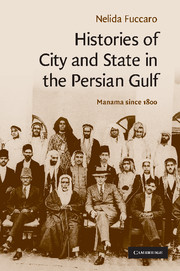Book contents
- Frontmatter
- Contents
- List of illustrations
- List of maps
- Acknowledgements
- Note on transliteration and terminology
- Glossary
- List of abbreviations
- Map 1 The Persian Gulf and Bahrain in the regional context
- Map 2 Bahrain's settlements
- CAMBRIDGE MIDDLE EAST STUDIES 30
- Introduction
- 1 Indigenous state traditions and the dialectics of urbanisation in Bahrain, 1602–1923
- 2 The making of Gulf port towns before oil
- 3 Ordering space, politics and community in Manama, 1880s–1919
- 4 Restructuring city and state: the municipality and local government
- 5 ‘Disorder’, political sociability and the evolution of the urban public sphere
- 6 City and countryside in modern Bahrain
- Conclusion
- Bibliography
- Index of persons, tribes and families
- Index of subjects
- Index of places
4 - Restructuring city and state: the municipality and local government
Published online by Cambridge University Press: 20 January 2010
- Frontmatter
- Contents
- List of illustrations
- List of maps
- Acknowledgements
- Note on transliteration and terminology
- Glossary
- List of abbreviations
- Map 1 The Persian Gulf and Bahrain in the regional context
- Map 2 Bahrain's settlements
- CAMBRIDGE MIDDLE EAST STUDIES 30
- Introduction
- 1 Indigenous state traditions and the dialectics of urbanisation in Bahrain, 1602–1923
- 2 The making of Gulf port towns before oil
- 3 Ordering space, politics and community in Manama, 1880s–1919
- 4 Restructuring city and state: the municipality and local government
- 5 ‘Disorder’, political sociability and the evolution of the urban public sphere
- 6 City and countryside in modern Bahrain
- Conclusion
- Bibliography
- Index of persons, tribes and families
- Index of subjects
- Index of places
Summary
With the establishment of a municipality in 1919, Manama entered a new era of modernisation and local government. The reorganisation of the town became an integral part of the process of reform which throughout the 1920s supported the creation of a modern state administration under the aegis of the Government of India. As Manama consolidated its position as the lynchpin of British informal empire in the Persian Gulf, it acquired a dual administrative and political personality as the centre of the modern state of Bahrain (Hukumah al-Bahrayn) and of a municipal administration (Idarah al-Baladiyyah). The merchant elite of the pearl boom effectively took control of local government as members of the town's municipal council (majlis al-baladiyyah). While municipal elections and the enforcement of legislation and taxation became the pillars of baladiyyah rule and the symbol of a new era of modernisation, the council provided the forum for the continuation of patronage politics cementing the traditional alliance between merchants and rulers.
After 1927 the municipal government survived the collapse of the pearling industry, which caused widespread economic dislocation throughout the Gulf and jeopardised the continuation of the reforms in Bahrain. The baladiyyah assisted the development of the town after the discovery of oil in 1932 but its political legitimacy was short-lived. After World War II, in particular, the new social and political forces which had emerged in the first two decades of the oil boom started to challenge municipal government and the old notable class as an integral part of a ‘reactionary’ ancien régime.
- Type
- Chapter
- Information
- Histories of City and State in the Persian GulfManama since 1800, pp. 112 - 150Publisher: Cambridge University PressPrint publication year: 2009

